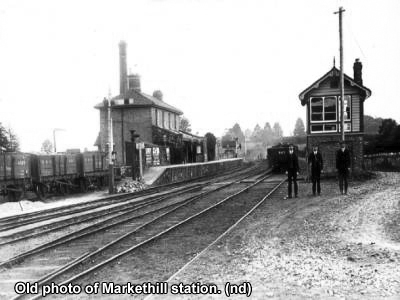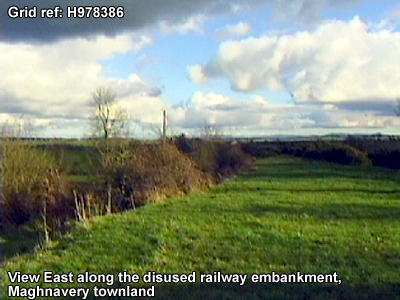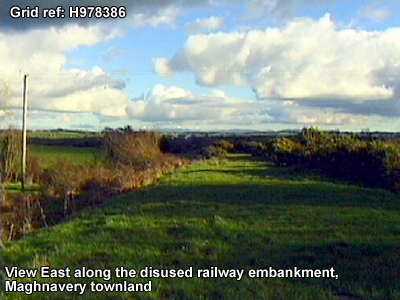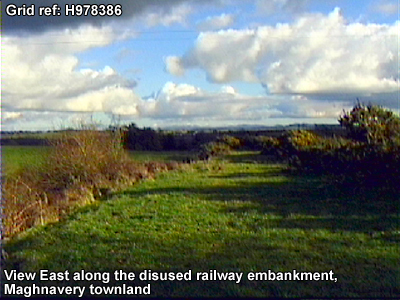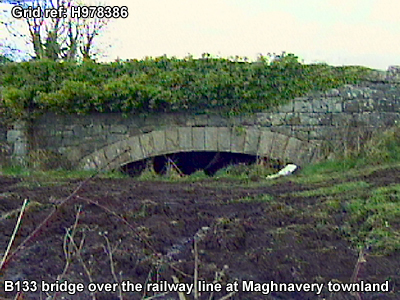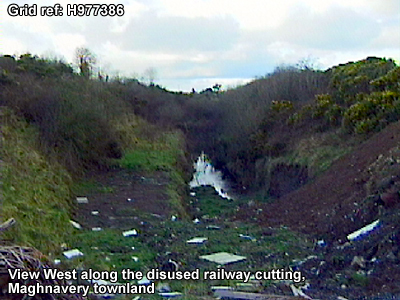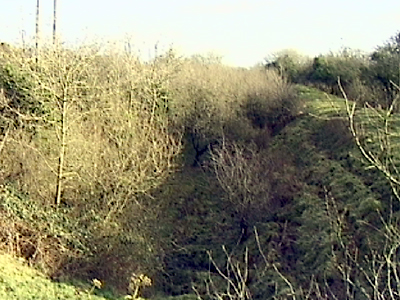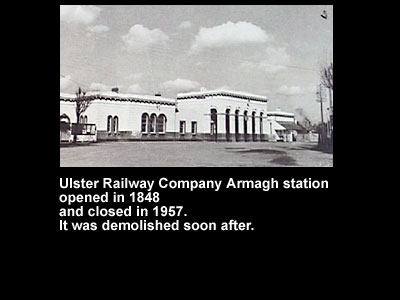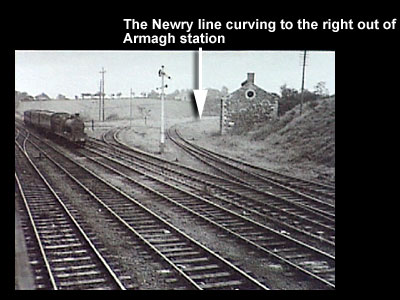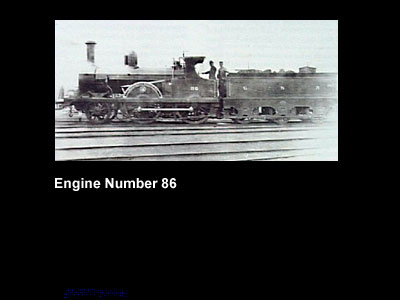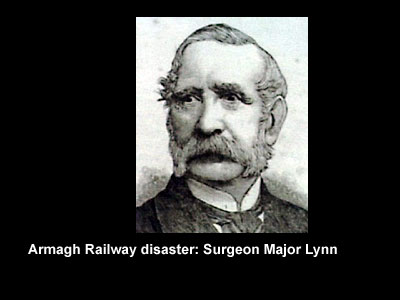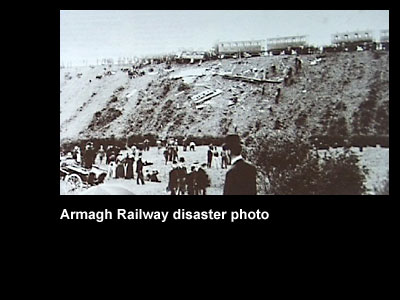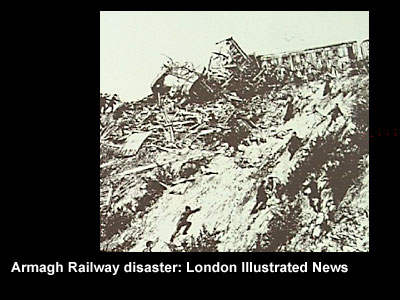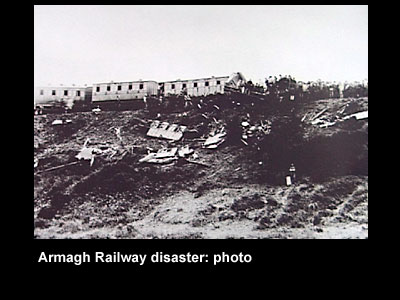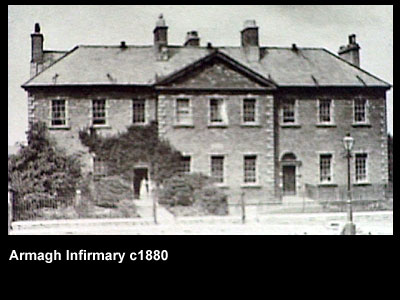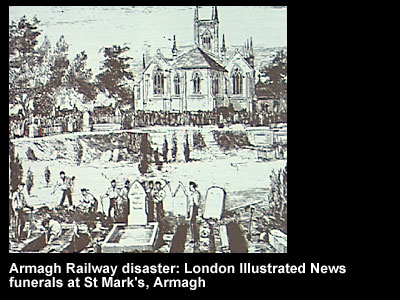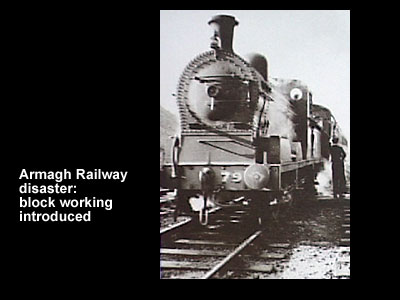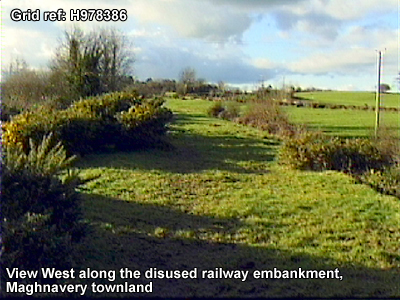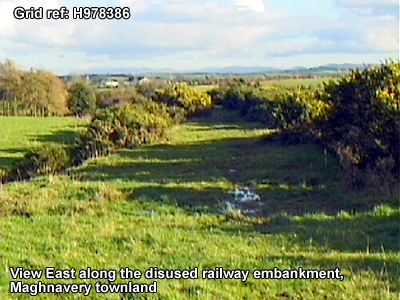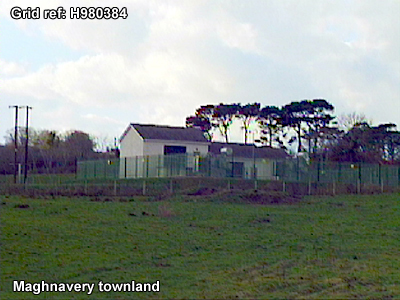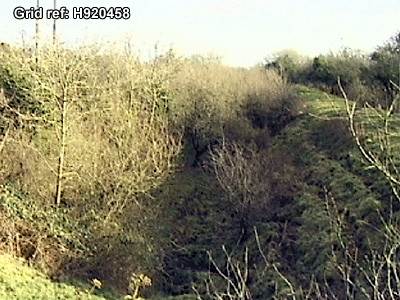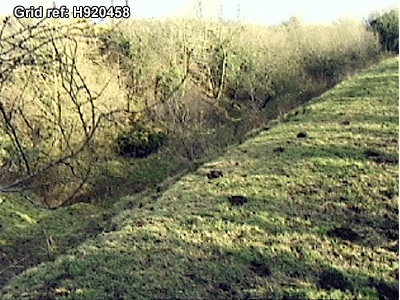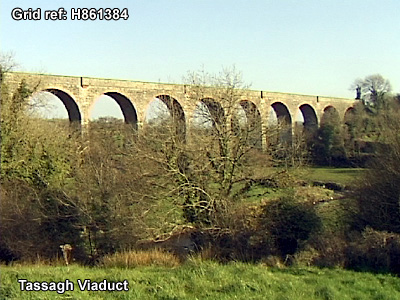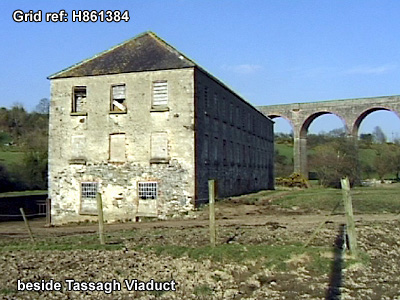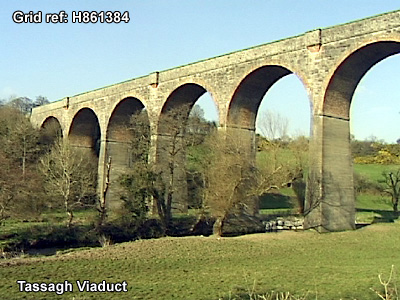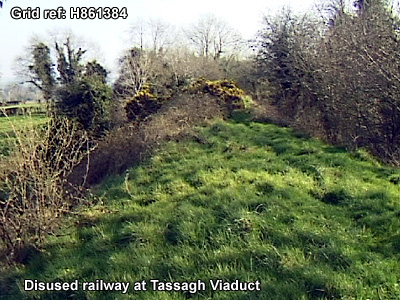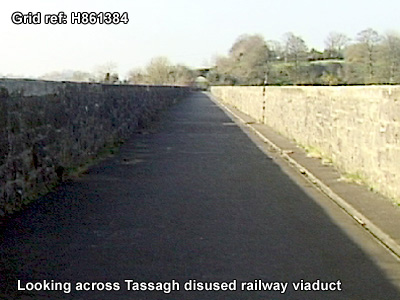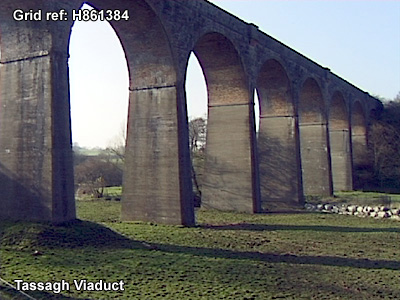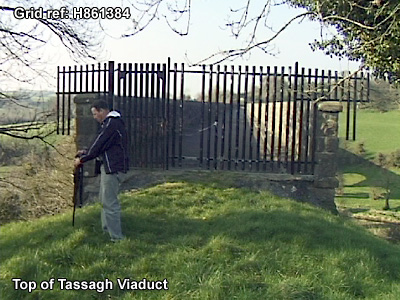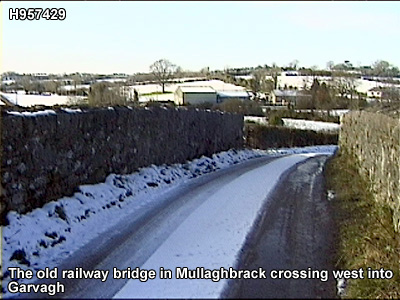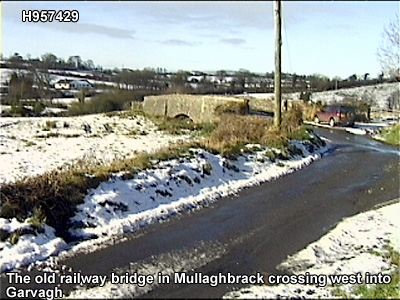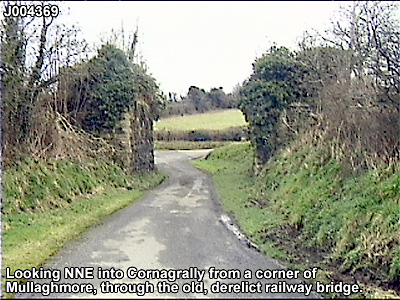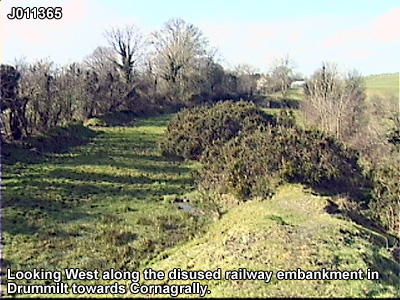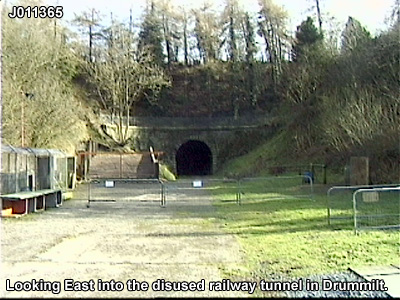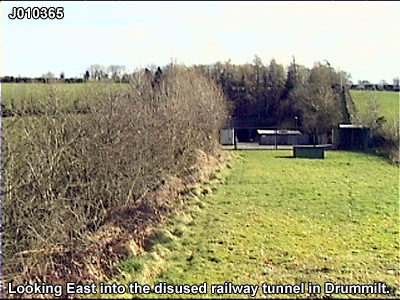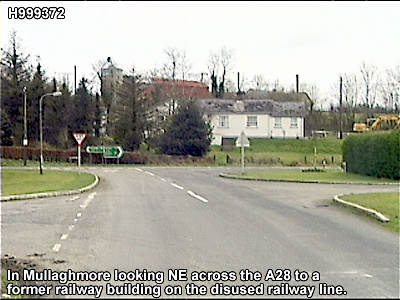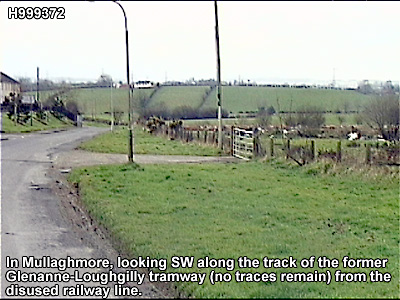
Article by T. G. Patterson in Harvest Home: The Last Sheaf (Dundalgan Press, 1975). pp. 104-112.
The earliest attempt to provide a railway in County Armagh was made in the closing days of the eighteenth century and the first printed reference to the undertaking that I have so far found appears in 1804. We are told that "an iron road had been talked about but no decision had been made." [1] This particular line was intended to link the port of Newry with the city of Armagh.
No further notice of the proposed railway crops up until William Edgeworth's [2] " Report on the proposed Railway from Armagh to Newry " was published in 1828 with a map attached showing that the Survey had been completed two years previously. The pamphlet in question is addressed " To William Blacker Esq." [3] and was printed by "N. Kelly and Son." From the introductory paragraph it is clear that the above "Survey and Report", was carried out under Mr. Blacker's instructions.
0n the first day of March, 1848 there was much excitement and speculation in the city. Steam as a method of transport was eagerly awaited by some of the inhabitants but heartily disapproved of by others. The railway had, however, at last reached Armagh (from Belfast) and was threatening to displace the horse-drawn stage coaches and long distance carriers.
The earliest railways were fairly primitive, horse-operated, and primarily for the purpose of conveying coal and minerals from the mines to the ports, an objective not so necessary in Ireland where such industries were an almost negligible quantity. This feature was somewhat of an encouragement in the development of passenger traffic and resulted in quicker appreciation of rail amenities here.
In I825, in the same year as the opening of the first railway in England, an Irish company known as the " Leinster and Ulster Rail Company" was promoted for the establishing of a railway between Dublin and Belfast, a proposal that failed to materialize. A line from Dublin to Kingstown was, however, opened in 1836 and in the following year the "Ulster Rail Company " was formed to construct a line from "the town of Belfast to the city of Armagh." In 1836 an Act was passed for the building of the Dublin-Drogheda Railway, a work completed in 1844, and now also part of the Great Northern, like the "Ulster" with which we are more particularly concerned.
Construction began on the Ulster Railway in 1837 and on the appointed day in 1839 the line was opened for traffic to Lisburn. In November, 1841 Lurgan was reached and in January, 1842 the rail-head had got as far as Seagoe where, owing to the marshy nature of the ground from there to Portadown, considerable delay was encountered resulting in the first train not reaching that station until September 12 of that year.
The advent of the Ulster Railway was well received until certain persons in Belfast learned that the Company intended to run trains on Sundays. One clerical gentleman alarmed his congregation by declaring " that every sound of the railway steam whistle was answered by a shout in hell," at the same time accusing the Company of "sending souls to the devil at ticket-prices." This was soon countered by an assertion from a railway supporter that "sin abounded less amongst travellers by rail as trains did not stop at public-houses."
The Armagh Extension Act was passed in 1845. This addition was very difficult to construct and the bridge over the Bann proved a source of great worry to the contractors, who believed stone or iron impossible owing to the boggy foundation on which it had to rest. The problem was eventually solved by a timber structure in five spans of thirty-nine feet each, the finished bridge being declared "a great ornament to the town, its elegant lightness giving but an inadequate idea of its solidity alld strength," a fact well borne out by its survival until 1879, in which year it was replaced by the present bridge to which alterations and renovations were made in ~908.
According to the Armagh Guardian a Government Inspector arrived in the city on Thursday, January 27, 1848, by rail. Rumour asserted that a favourable report would be made and the line soon opened to traffic. On February 7, at half-past two o'clock, a full train with fourteen of the Directors, arrived in the city. Having dined at the Beresford Arms they returned by rail to Belfast after arranging for the opening to take place on February 28 or March 1. The Beresford Arms was then the chief hotel in the town and lists of arrivals at that establishment included the Marquess and Marchioness of Downshire, Lord and Lady Sandys, the Earl of Enniskillen, Lord and Lady Erne, Lord Caledon, etc., all of whom were set out in the columns of the Guardian in much the same way as distinguished visitors to Dublin now appear in The Irish Times.
On February 28 the first list of trains and fares between Armagh and Belfast was published with the information that the line would be opened on March 1. On week-days there were six trains up from Belfast and six down from Armagh, and on Sundays three each way; fares 3s. 9d., 3s. 0d. and 2s. 1d. according to class. It is interesting to note that despite the speeding-up of trains the time taken by a journey from Armagh to Belfast is much the same as it was in 1848. Trains then proceeding to Belfast were spared the waits at Portadown that, in the closing days of the railway, were so annoying a feature. There is also the fact that stations between here and Belfast were less numerous: increased halting places have left us pretty well as we were in the days of the slower trains.
Despite the importance of the opening ceremony the Guardian took the matter calmly. Its comment was: "The long-looked for event took place on Wednesday last. The first train arrived here at ten o'clock and was welcomed by crowds of our fellow citizens who had congregated to witness the novelty. The regular traffic is now opened with every probability of remuneration."
At the same time this newspaper carried advertisements from the proprietors of the Armagh-Monaghan-Clones Day Coach setting out link-ups from Monaghan and Clones with the rail extension from Armagh to Belfast. The coach left the Charlemont Arms daily and this establishment had an advertisement reminding the public that it was the nearest hotel to the Ulster Railway Station and that it had provided an omnibus to carry passengers gratis to and from the station. This omnibus, however, failed to impress one traveller who complained that he came up by the first train from Belfast a few days after the opening and was put into a vehicle made in Edinburgh. That he considered an affront to the coach-builders of Armagh who were, indeed, famous for workmanship and design.
From the Guardian of March 13 we learn that on the Sunday following the opening the crowds were so great that on the succeeding Sunday the non-travelling public "were excluded from entering the station enclosure," a proceeding which earned the approval of the then editor, who feared that if the practice had continued accidents might have occurred. The same issue contained a letter from a traveller who had tried the new method of travel and found it satisfactory and pleasant, besides approving of the omnibuses belonging to the different hotels. Another item of interest at this period was a correspondence between certain readers of the paper relative to the station at Richhill suggesting that Stonebridge would better serve the area and be a more convenient stop.
Two years later (Armagh Guardian, June 1850) Mr. Wiltshire, then proprietor of the Beresford Arms Hotel (in co-operation with Mr. Jones of Enniskillen) announced that a four-horse coach would run between the recently-opened station at Armagh and Enniskillen, leaving Armagh on arrival of the 9.~5 a.m. train from Belfast and reaching Enniskillen at 4.30 p.m.; a similar coach leaving Enniskillen daily at 9 a.m., entering Armagh at 4.5 p.m. and linking up with the afternoon train for Belfast, an amenity resulting in a shortening of the journey from Belfast to Enniskillen by two hours.
The construction of the line to Armagh completed the original scheme of the Ulster Railway Company, but the line was later continued to Monaghan in 1858 and to Clones in 1863.
The trains of those days were very different from the trains of to-day. The earliest Ulster Railway carriages ran on four wheels and were divided into "bodies" or compartments, first-class bodies holding eight passengers whilst second-class accommodated twelve. In March of 1840 the Company advertised that third-class carriages would be available in April. These were simply open waggons into which people were packed standing.
The line was then a single track and as it was built north of the various towns all its station entrances were on the south side of the railway. At Armagh the first platform roof or shelter was a gloomy affair lighted by a few sky-lights. The first stationmaster, Mr. Mulholland, lived in the Charlemont Arms and was a favourite socially. At that time there was also a "goodsmaster", a well-known bird fancier, famous for his pens of pheasants and partridges which he kept in one end of the goods store.
The ticket office was a little round canister-like enclosure in the main hall that, in times of stress or excitement, was liable to overturn, an accident from which the small boys of the neighbourhood often reaped a profit. Railway Street had not then been opened or developed. Banbrook Hill was, of course, then in being and was the only entrance to the city from that side.
In 1842 the Company decided to run goods trucks and thirdclass passengers on a separate train but in 1848, owing to increased goods traffic, third-class carriages were again attached to passenger trains and were fitted up with rough seats.
About this time the Directors were pained to discover that many of the people who formerly travelled first-class had dropped down to second. At this period third-class carriages became fitted with roofs despite some opposition on the part of certain directors and shareholders. Similar conditions existed in England and indeed there is a record of one company employing a sweep to frequent third-class carriages and rub up against well-dressed people travelling therein, thus reminding them of their station in life and the necessity of journeying in their proper class. These early carriages had no interior lighting or heating. Later oil lamps were introduced and various forms of heating tried out such as warming-pans filled with hot water.
When the railway first came to Armagh there was great consternation in the country district. It was alleged, and indeed widely believed, that such speedy transit would have a bad effect on health generally, that the smoke of the engines would kill all the birds, that cows would cease to give milk, that the race of horses would become extinct, that factories and houses would be set on fire from sparks and that eventually Ireland as a whole would go up in smoke.
The formation of the lines from Belfast to Armagh and from Dublin to Drogheda led to an Act being obtained in the following year to establish the Dublin and Belfast Junction Railway, by which approval was given for a line from Drogheda to Portadown. This reached Dundalk on February 15, 1849, the Dundalk-Castleblayney line being opened on the same day, so that with road transport from Castleblayney to Armagh an eight-hour journey between Dublin and Belfast became possible. Previously there had been a similar service from Drogheda station to Armagh via Ardee and Castleblayney, as well as one to Dungannon by Newry and Armagh.
The next section opened was that between Dundalk and the Wellington Inn near Newry, which came into use on July 31, 1850, whereupon an omnibus was pressed into service for the conveyance of passengers between that point and Portadown, following which most of the Belfast traffic went that way instead of by Castleblayney and Armagh. The next portion was a section starting from Portadown which was opened to Mullaghglass, near Goraghwood, on January 6 1852. This left only a short distance of some six miles to be completed, but it involved the building of the Bessbrook Viaduct and intensive rock-cutting. Work was quickly pushed ahead and on June 10, 1852 the gap was closed.
At this time passengers passing through Drogheda had to drive from a station south of the river to one on its northern side or the other way round if travelling in an opposite direction. To remedy this it was decided to erect a bridge to carry the railway over the Boyne, and a wooden structure was built and opened to traffic on June 22, 1853. This was replaced by an iron bridge in 1855, which was practically rebuilt in 1930-32.
Various efforts were made towards uniting the "Dublin and Drogheda Railway " with the "Belfast and Dublin Junction Compan " and in 1875 they ceased their separate existences and became the Northern Railway of Ireland. This brought about further amalgamations and resulted in the acquisition of the "Irish North-western" and "Ulster" with their subsidiary lines in 1876 and the re-grouping of the four companies under the revised title of "Great Northern Railway of Ireland."
In I879 the new Company purchased " The Newry-Armagh Railway," a local line with an interesting history. It was incorporated in 1845 as the Newry-Enniskillen Railway to provide a link between those towns via Armagh and Clones, but the scheme was greatly retarded by the Famine events of 1846-47. The opening from Newry to Goraghwood took place in 1854. Three years later its name was changed to the "Newry-Armagh " with which town it was linked up at the Ulster Railway Station in 1865. It was a difficult line to construct and included steep gradients and two tunnels. This line's relations with the Newry-Warrenpoint Railway — opened in 1849 — were at first unfriendly but a union took place in 1861 following which rails were laid between the two Newry stations and a through service thus became available between Armagh and Warrenpoint.
The "Newry-Armagh" line is famous in Irish railway annals as the scene of Ireland's worst rail disaster in which eighty people lost their lives and close on two hundred were injured, when on the 12th June, 1889 an excursion train came to grief at Killuney, less than two miles from the city. A detailed account of the events leading up to this tragic accident would take up too much time, but I should mention that the investigation that followed the disaster produced the long overdue Act enforcing automatic braking, block signalling and the interlocking of all signals.
This was not the first railway accident in the county. In 1886 there was a tragic accident on the Belfast-Dublin line in in Brackagh Moss,[4] resulting in six people being killed and forty injured. This was due to the neglect of the permanent way by which the track gave way and the train ran off the line.
The building of the Bessbrook or Craigmore Viaduct was earlier the occasion of an accident wherein Laurence Halfpenny, whilst engaged on the erection of scaffolding, fell from a height of sixty feet and was killed on the spot. [5] In the same year a second accident occurred at the same place resulting in the death of John Hollywood, who was precipitated from a height of sixty-four feet and died half an hour later. [6] In the following month a third accident at the Viaduct deprived a man named Ferrigan of his life. [7]
When the construction of the Armagh-Newry line reached Drummondmore a temporary halt or station came into being and was in use whilst the deep cutting between that point and Armagh was excavated. Later, when the line was completed to the city, the train ran into the present station on the platform known to old inhabitants as the "Warrenpoint Terminus."
It was originally intended that the Armagh-Newry line should continue to Enniskillen. The cutting of the tunnels at Loughgilly, however, cost more than was estimated and as a result the capital subscribed was only sufficient to bring the line to Armagh. The Ulster Railway, by then, had brought its line to Clones and the Dundalk and Enniskillen Company was operating via Clones.
The latest line to reach Armagh was the " Castleblayney-Armagh," begun in 1903, of which the Armagh-Keady section was opened in 1909. It reached Castleblayney in 1910 and in the following year became vested in the Great Northern. A partial closure took place in 1914, and in 1935 the track between Keady and Castleblayney was lifted.
The Keady-Castleblayney section was a considerable time coming into being, due to the opposition of the Great Northern, who were alarmed by the possibility of alternative travel facilities from Dublin to Belfast by Navan, Kingscourt and Armagh. The link-up between Kingscourt and Castleblayney, however, never came into being. The line was unsuccessful flnancially and, owing to gradients and cuttings, most expensive to construct.
The most recent portion of the Great Northern to be affected is the line from Dundalk to Clones. On Saturday night, October 12 1957, the last passenger train moved out from Dundalk on its final run. Many people made the journey to Clones: indeed the train was packed. Leaving Dundalk the noise was terrific. In the yards the sirens of the engines wailed mournfully whilst fog signals added to the tumult.
The passing of our railways has most certainly evoked regret. Perhaps I am somewhat sentimental when I think back upon their contribution as pioneers of comfortable travelling conditions. On the final run from Armagh. to Portadown the station was crowded by local people who came down to say "Good-bye." Despite the fog signals and the excitement generally, it was a sad occasion. Photographers' flashlights blinked at us as we crowded into the train. The time came to move off but somebody pulled the communication cord, bringing the brakes into action. This was carried out a second time, but at last we moved out.
The train was manned by William Dudley, driver; W. Moore, fireman; and Liam Kilpatrick, guard. We soon reached the Retreat Halt where we found a crowd awaiting us and were held up for a considerable time. Eventually we moved onwards in a battery of cheers to Richbill Station where we found an even larger concourse of people awaiting us. There we were given a royal welcome and again, to the accompaniment of fog signals and more cheers, proceeded to Portadown. There we found a practically empty station. Evidently the inhabitants of the borough were quite uninterested in the fact that no more trains would pass through Portadown on their way to Armagh. We emerged from the carriages quickly and at the barrier were allowed to retain our tickets. Thus ended our farewell journey.
Footnotes 1. C. Coote, Statistical Survey of County Armagh (1804), p. 380. The same authority states that a canal or an iron road from Castleblayney to Dundalk was also determined. 2 Of Edgeworthstown, Co. Longford. Son of Richard Lovell Edgeworth, the celebrated writer on education and inventions, born 27 January, 1794, died 1829. 3 Of Elm Park, Co. Armagh, born 1776, died 20 October, 1850. 4. A stretch of bog immediately south of Portadown. 5. Newry Telegraph, October 6, 1851. 6. ibid., November 16, 1851. 7. ibid., December 18, 1851.
In the accompanying recording, Billy Henry relates a story told to him about the building of the railway through the area.

Use the audio controller to listen to this talk, given in 2003.
In the accompanying audio recording, Sam Hetherington talks about Ireland's longest railway tunnel under Lissummon Hill and about Ireland's greatest railway disaster (1mins 37s).
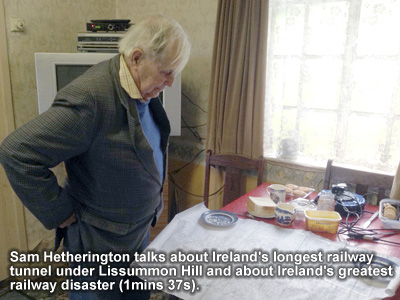
Use the audio controller to listen to this talk, given in 2013.
